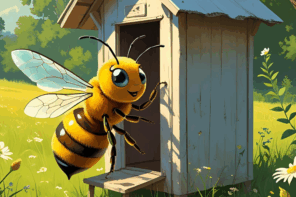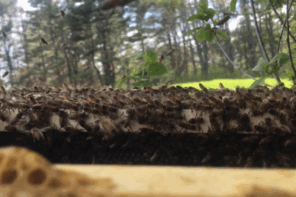Reasons you may not have thought of.
by Joe Traynor
Ask a beekeeper – commercial, sideliner or hobbyist – why he/she keeps bees and the answer could be any or all of the following.
- 1. The opportunity to be outdoors – to commune with Nature
- 2. Fascination with observing the organizational skills and inner-workings of honey bee colonies
- 3. Setting yourself apart from the crowd – delving into a vocation or avocation that few would consider
- 4. Producing honey
- 5. To earn a living
- 6. For the therapeutic value of bee stings (or for masochists)
- 7. For the relatively independent life-style
- 8. You inherited a bee farm
One or more of the above answers probably fits many beekeepers, but from a five year stint running 500 colonies + 30 years of observing commercial beekeepers, I have concluded that the major reason people keep bees is difficult for them to articulate because it is so embedded in the fabric of the endeavor that it doesn’t stand out and is therefore not readily apparent – a “can’t see the forest for the trees” phenomenon.
Here’s my take (and I certainly won’t argue with anyone who feels differently): the main reason we keep bees is to experience the highs and lows that come with the job. What other occupation can provide so many highs and lows?! – not only from year to year, but from month to month, day to day or even hour to hour as one tends hive after hive during a working day. The dour German philosopher Arthur Schopenhauer has stated “To overcome difficulties is to experience the full delight of existence” Welcome to the world of beekeeping Professor Schopenhauer!
For a commercial beekeeper, going from one apiary site to the next can be a roller coaster ride – exhilarating if all the colonies are packing in nectar and pollen, depressing if one finds disease or pesticide damage or that another beekeeper has parked a semi-load of bees across the road from your location.
Beekeeping highs and lows can also be experienced in a single apiary site on a given day as one goes from a robust colony to a failing colony only a few feet away. When spending a day in an apiary of about 100 colonies – re-queening, medicating, feeding, if necessary – many beekeepers have learned to end the day with a top-producing colony, thus allowing a pleasant ride home and a restful sleep that night. Ending the day with a sick colony can put one in a dark mood followed by a silent supper and a restless night of sleep. For the backyard beekeeper with only two hives, it may be more difficult to wind up the day with a gang-buster colony – add two more colonies to improve the odds.
The highs and lows of beekeeping usually fall into a seasonal pattern. As colonies build up in the spring and happy, busy workers communicate ever expanding flower sources, the beekeeper can’t help but catch the mood of the colonies and feel that all things are possible. An occasional cool spell in late spring or early summer can trigger a nosema outbreak for the unprepared beekeeper but the Summer months are generally happy months for both bees and beekeepers as nectar flows continue and extensive brood-rearing keeps colonies well ahead of any visible damage from omnipresent Varroa mites. In contrast to Spring, the Fall months, and certainly the Winter months, can be tough as colony populations shrink and beekeepers face the onerous, often depressing task of culling out or killing weaker colonies that might not make it through the Winter or that will require expensive feeding and medication to meet February almond pollination standards (usually eight frames of bees).
When honey bees are thriving, the beekeeper enters into an unspoken pact with his charges: you help me, and I’ll help you. Or, as some beekeepers have put it: if I take care of my bees, my bees will take care of me (a basic axiom of commercial beekeeping). A silent, cooperative bond develops between bees and beekeeper when the bees are thriving, so one can understand why a beekeeper might feel betrayed when he enters a beeyard in the Fall and robbing bees inflict multiple stings during his attempts to service their colonies; the beekeeper might mutter under his breath: ungrateful so and sos – after all I’ve done for you this year, you treat me like this? It’s as if your always-friendly, always-loyal dog snapped at you when you fed him instead of licking your hand in gratitude. The beekeeper inherently knows that such thoughts are not rational – that bees respond to environmental cues and have no concept of any relationship with their keepers – but it’s still difficult for a beekeeper not to feel resentment if/when their bees become aggressive in the Fall. Taking the bees’ point of view, they may feel that the friendly giant that worked side by side with them in the Spring has turned into a menacing intruder that must be repelled in the Fall.
In his detailed scholarly article, The Fall and Rise of the Honey Bee, Peter Loring Borst reminds beekeepers that the 30+% winter losses currently incurred by U.S. beekeepers are no different than the losses reported during the 100 years prior to the introduction of Varroa mites to the U.S. and to the later finding of nosema ceranae here. It is a tribute to the skill of today’s beekeepers that they can continue to hold Winter losses at historic levels. Certainly, shrinking bee habitat and the efforts needed to control Varroa and nosema ceranae have made beekeeping far more difficult today than in past years but overcoming these difficulties can provide the “delight” envisioned by Schopenhauer.
Bee colonies in temperate climates cope with Winter by reducing their metabolism to remain young and to preserve resources (much like hibernating bears). Although hibernation is not an option for beekeepers some have adopted another honey bee strategy: repairing and upgrading equipment. Bees plug cracks and holes in their homes with propolis as winter sets in. Beekeepers sort, replace and repair old combs and supers. Keeping busy is a proven antidote to the winter blahs.
The extreme contrast between the euphoric days of Spring and the somber, shorter days of Fall and Winter sets a beekeeper up for mild to severe manic-depression. Little wonder that more than one commercial beekeeper has been diagnosed as manic-depressive (aka bi-polar) and that many more lie along a continuum from mild to moderate manic-depression. Many individuals in the general population are also susceptible to depression during the shorter winter days, but most are isolated from nature’s cues. For beekeepers, the silent, dormant state of honey bees in the winter is a constant reminder that things aren’t quite right. The highs of beekeeping are much higher than those experienced by the general public, and the lows probably lower as the bees transfer their moods to beekeepers during the year. A future psychiatry journal may well contain an article: Transference: Explaining the above normal incidence of manic-depression among beekeepers. A number of drugs are available for those with clinical manic-depression but it can take time to arrive at the proper combination or dose for a given individual. Some manic-depressives quit medication because they miss the euphoric highs of past years – they have also discovered that they can get twice as much work done and require very little sleep during their high or manic intervals. An understanding spouse is probably better than medication in treating manic-depression (here’s to the long-suffering wives of manic-depressives!); the camaraderie enjoyed with fellow beekeepers at winter bee meeting can also pull one out of a depressive cycle and for California beekeepers, a wet winter can be uplifting.
Knowledge and patience are tools that can be used by beekeepers that suffer from Winter depression: knowledge that the days get longer after December 21st and that Spring always has and always will follow Winter; patience to hold on until almond bloom starts in February. Here’s a sure-fire cure for beekeepers that suffer from winter depression, especially suitable for those that store their bees in controlled-temperature buildings in December and have a competent person monitoring the storage facility: Schedule a trip to the southern hemisphere – Australia, Chile, New Zealand, South Africa – and poke your head into a few bee hives while you’re there. When you return in time for almond bloom you will enjoy a seamless re-entry and be better able to cope with that picky almond grower or bee broker who complains that your bees aren’t working like they should (the remedy: suit him up and open a few hives for him).
Beekeeping can be one of the most rewarding of all professions if one can overcome our current challenges. Pity the poor accountant, bank teller, bank CEO, stock broker or government bureaucrat who must endure day after day of the same old monotony. Relish and retain the highs of beekeeping and develop coping mechanisms for the inevitable lows, buoyed by the certain knowledge that the highs will surely come again and may well be just around the corner.
Note: This article is not meant to imply that most beekeepers suffer from any degree of manic-depression – many are totally immune from the malady. As one who has been hit by the depression demon from time to time, the intention here is to ensure affected beekeepers that they are not alone and that measures exist to minimize depression. Those that have depression-immunity may have wasted their time reading these words but if their immunity has a genetic basis they might well consider volunteering for a DNA analysis by Monsanto in the hope that as DNA data accumulate, Genetic Modification will eventually cure depression in everyone.
Joe Traynor is an almond pollination broker and long time contributor from Bakersfield, CA.









